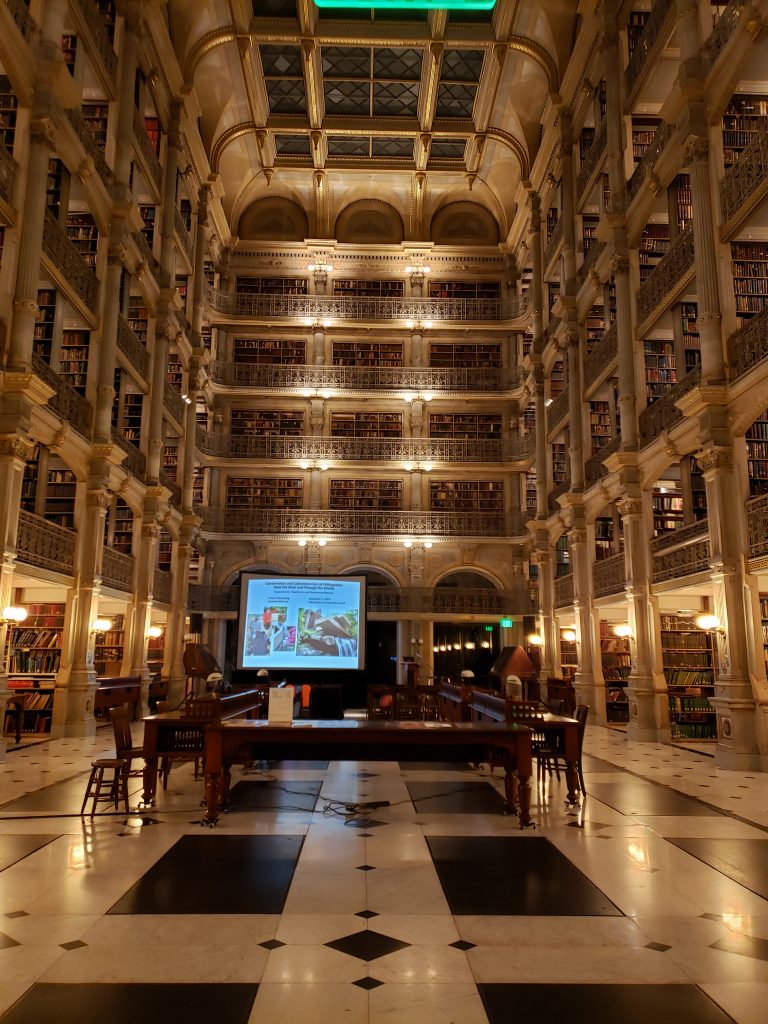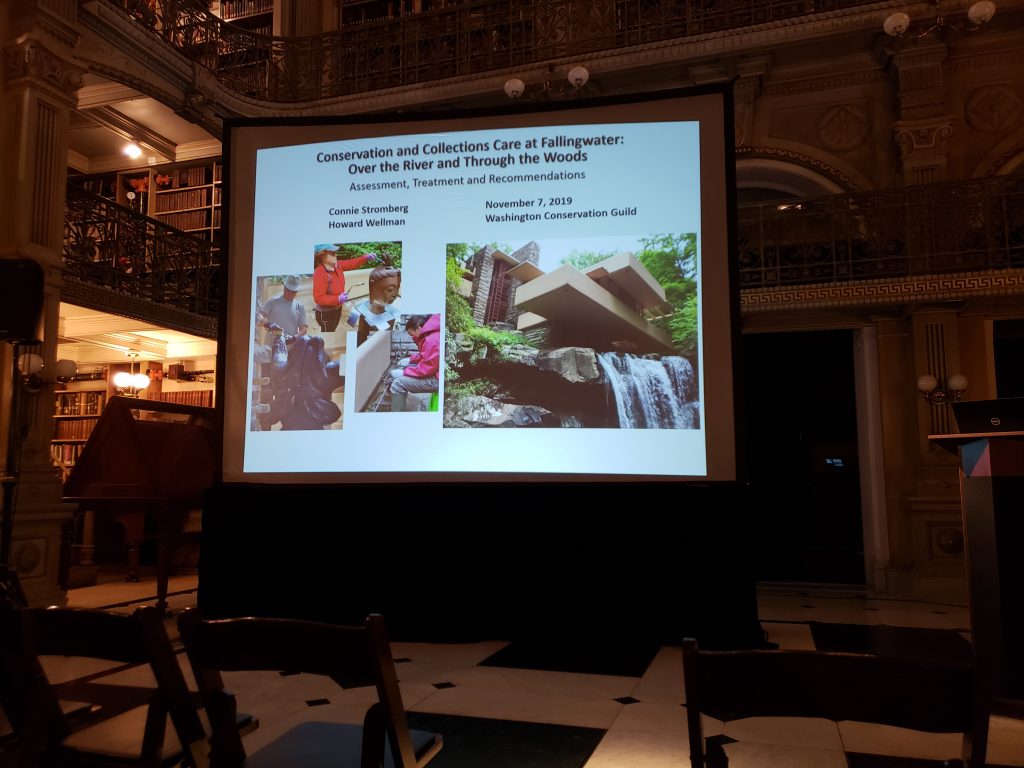The George Peabody Library, Johns Hopkins University, Baltimore, MD
7 November 2019
“Conservation and Collections Care at Fallingwater: Over the River and Through the Woods”
Connie Stromberg, Conservator/Owner, Stromberg Conservation LLC
Howard Wellman, Conservator/Owner, Wellman Conservation LLC
Safe from the rainy cold weather and nestled inside the cathedral of books known as the George Peabody Library, the Washington Conservation Guild (WCG) held its third meeting of the 2019/2020 season Thursday evening.

Paul Espinoza, curator of the George Peabody Library, welcomed guests with an introduction to the stunning location, elucidating details of its cast-iron construction, Historicist style, and continuing legacy. Further opening remarks from Jayne Girod Holt, president of WCG, notified audience members of upcoming events and announcements, including the Fairfax Library preservation fair and its call for volunteers in the spring, the compilation of a list of interns and fellows in the DC area, and the new social media presence for WCG: @dcconservators.
After a quick introduction of the speakers from WCG Board Member Josie Maldonado, Connie Stromberg, owner of Stromberg Conservation LLC, began her talk. In fall of 2017, Stromberg was asked to do an assessment of the outdoor sculptures at the Fallingwater historic house designed by Frank Lloyd Wright in Mill Run, Pennsylvania. The sculptures face many challenges in this outdoor environment, including rainy weather, freeze-thaw cycling, biological growth and the effects of, pollution and debris deposition. For the assessments, she prepared individual reports for each sculpture, with estimated treatment costs. Treatments began in 2018 and ranged from removing old wax and recoating a Richmond Barthé concrete statue in black microcrystalline wax, to filling losses in a Peter Voulkos ceramic with mortar and in-painting restored areas with UV-resistant acrylic paints, to cleaning and coating a cast iron Buddha head.
Particular highlights of objects treated include a damaged Jacques Lipchitz’s “Mother and Child” in bronze. The sculpture was knocked into the stream that runs under the historic house when the wall it was mounted on was broken by logs during a torrential storm. It was chained to the wall behind and the metal surface had sustained deep gashes. Exposed bare metal scratches were repatinated and the sculpture was then hot waxed with clear microcrystalline wax.
An indoor Lipchitz bronze, “Harpist,” had waxy green corrosion products on its underside as a result of contact with its wooden base. A custom-fit covering of Tyvek was placed over the wood core under the sculpture to prevent contact with the wood.

For the treatment of the mixed ferrous and non-ferrous metal sculpture “Landscape in the Air” by Joseph Goto, which was bent after a visitor tripped over it, Stromberg sought the aid of metalsmithing experts from Touchstone Center for Crafts in order to help repair the piece. The sculpture was straightened as much as possible without risking further damage. The piece was then coated inmicrocrystalline wax and relocated to help prevent a similar accident from happening again in the future.
Next to take the stage was Howard Wellman, owner of Wellman Conservation LLC, who helped Stromberg with treating some of the pieces at Fallingwater. Among the treatments he carried out were those for various sculptures by the Mexican artist Magaña. One, a porous volcanic tuff has a carved recess which pools water and encourages biological growth. Mechanical cleaning and D/2 Biological Solution were used to remove deposits and help deter future biological growth. Old repairs removed and losses filled with Edison Thin-Fill mortar.
Another Magaña sculpture, in wood, suffered from dampness and small areas of rot. Boracare™, an aqueous borax solution, was applied to treat the wood rot fungus. Lastly, a Richard Hunt bronze, “Bear Run,” was mechanically cleaned of many years of driveway dirt and grime, and waxed with microcrystalline wax.
A key takeaway for the staff at Fallingwater was the introduction and suggestion of routine maintenance plans. For bronzes, it was determined that superficial soiling could be gently washed off by staff, while every two to three years a conservator should be called out to touch up the wax coating. With this plan, the current wax coating should last a decade or so before complete removal and reapplication is necessary. For ferrous iron, the best solution is to move objects indoors. However, where this is not a possibility, yearly inspections are key to ensuring the protective wax layers are maintained. Lastly, for the stone objects, restricting water from pooling by sponging it out is an easy way to prevent future biological growth, and continued yearly applications of a biocide provides additional protection.
After thanks were given, with a particular emphasis of gratitude to the Western Pennsylvania Conservancy, a quick round of questions and answers was held. Questions of whether or not the maintenance plan would be followed was answered with hope despite the already-heavy workload of the staff. The possibility of relocating sculptures was also addressed, however the situation is unlikely except in rare exceptions. Lastly, the idea of using replicas was among the questions raised, for which the response was that continued work with maintenance plans and conservators should help ensure the actual artworks to safely survive. The meeting wrapped up with closing remarks from Jayne Girod Holt, and a generous tour of the upper levels of the Peabody Library by Paul Espinoza. Between the stimulating discussion with colleagues, interesting work of the presenters, and stunning location of the meeting, this will be one to remember.
Summarized by Austin Anderson, Graduate Intern in Objects Conservation, The Walters Art Museum